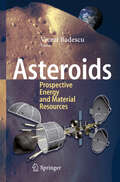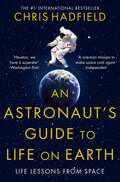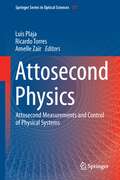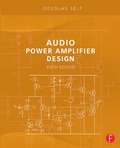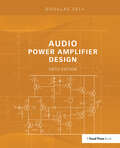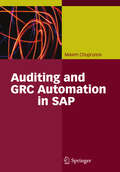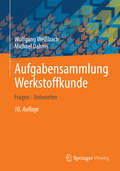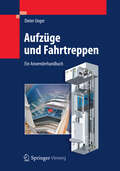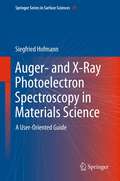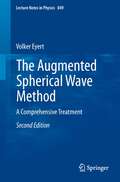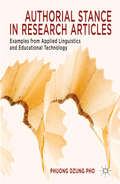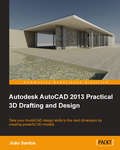- Table View
- List View
Asteroids: Prospective Energy and Material Resources
by Viorel BadescuThe Earth has limited material and energy resources while these resources in space are virtually unlimited. Further development of humanity will require going beyond our planet and exploring of extraterrestrial resources and sources of unlimited power. Thus far, all missions to asteroids have been motivated by scientific exploration. However, given recent advancements in various space technologies, mining asteroids for resources is becoming ever more feasible. A significant portion of asteroids value is derived from their location; the required resources do not need to be lifted at a great expense from the surface of the Earth. Resources derived from Asteroid not only can be brought back to Earth but could also be used to sustain human exploration of space and permanent settlements in space. This book investigates asteroids' prospective energy and material resources. It is a collection of topics related to asteroid exploration, and utilization. It presents past and future technologies and solutions to old problems that could become reality in our life time. The book therefore is a great source of condensed information for specialists involved in current and impending asteroid-related activities and a good starting point for space researchers, inventors, technologists and potential investors. Written for researchers, engineers, and businessmen interested in asteroids' exploration and exploitation. Keywords: Asteroids, Asteroid exploration, Asteroid exploitation, Energy sources, Space Resources, Material Resources, In-Situ Resource Utilization, Mining
Asthma in the Workplace
by Jean-Luc Malo David I. Bernstein Moira Chan-YeungOccupational factors are responsible for a large percentage of cases of asthma in adults of working age. Any irritant generated at high concentrations can cause occupational asthma, and early diagnosis is critical because cure is still possible at this stage. This latest edition of Asthma in the Workplace reflects the rapid pace of discovery and re
An Astronaut's Guide to Life on Earth: What Going To Space Taught Me About Ingenuity, Determination, And Being Prepared For Anything
by Chris HadfieldColonel Chris Hadfield has spent decades training as an astronaut and has logged nearly 4,000 hours in space. During this time he has broken into a Space Station with a Swiss army knife, disposed of a live snake while piloting a plane, been temporarily blinded while clinging to the exterior of an orbiting spacecraft, and become a YouTube sensation with his performance of David Bowie's 'Space Oddity' in space. The secret to Chris Hadfield's success – and survival – is an unconventional philosophy he learned at NASA: prepare for the worst – and enjoy every moment of it.In his book, An Astronaut's Guide to Life on Earth, Chris Hadfield takes readers deep into his years of training and space exploration to show how to make the impossible possible. Through eye-opening, entertaining stories filled with the adrenaline of launch, the mesmerizing wonder of spacewalks and the measured, calm responses mandated by crises, he explains how conventional wisdom can get in the way of achievement – and happiness. His own extraordinary education in space has taught him some counter-intuitive lessons: don't visualize success, do care what others think, and always sweat the small stuff.You might never be able to build a robot, pilot a spacecraft, make a music video or perform basic surgery in zero gravity like Colonel Hadfield. But his vivid and refreshing insights in this book will teach you how to think like an astronaut, and will change, completely, the way you view life on Earth – especially your own.
Atlas of Remote Sensing for World Heritage: China
by Huadong GuoAtlas of Remote Sensing for World Heritage: China describes the UNESCO Natural and Cultural Heritage Sites in China and focuses on the interrelationship between culture and nature as well as on the breadth and complexity of China's world heritage sites. It emphasizes the application of space technology to world heritage, offering a vivid portrayal of China's forty world heritage sites and their surrounding environments by using multi-band, multi-resolution, multi-temporal spaceborne and airborne remote sensing data and 3D models. The book is a valuable resource for researchers in fields related to world heritage and to anyone with an appreciation of natural beauty and cultural landmarks. Professor Guo Huadong is the Director-General of the Center for Earth Observation and Digital Earth, the Chinese Academy of Sciences, China.
Atmospheric Effects in Space Geodesy (Springer Atmospheric Sciences)
by Johannes Böhm and Harald SchuhVarious effects of the atmosphere have to be considered in space geodesy and all of them are described and treated consistently in this textbook. Two chapters are concerned with ionospheric and tropospheric path delays of microwave and optical signals used by space geodetic techniques, such as the Global Navigation Satellite Systems (GNSS), Very Long Baseline Interferometry (VLBI), or Satellite Laser Ranging (SLR). It is explained how these effects are best reduced and modelled to improve the accuracy of space geodetic measurements. Other chapters are on the deformation of the Earth’s crust due to atmospheric loading, on atmospheric excitation of Earth rotation, and on atmospheric effects on gravity field measurements from special satellite missions such as CHAMP, GRACE, and GOCE. All chapters have been written by staff members of the Department of Geodesy and Geoinformation at TU Wien who are experts in the particular fields.
Atmospheric Pressure Plasma for Surface Modification
by Rory A. WolfThis Book’s focus and intent is to impart an understanding of the practical application of atmospheric plasma for the advancement of a wide range of current and emerging technologies. The primary key feature of this book is the introduction of over thirteen years of practical experimental evidence of successful surface modifications by atmospheric plasma methods. It offers a handbook-based approach for leveraging and optimizing atmospheric plasma technologies which are currently in commercial use. It also offers a complete treatment of both basic plasma physics and industrial plasma processing with the intention of becoming a primary reference for students and professionals. The reader will learn the mechanisms which control and operate atmospheric plasma technologies and how these technologies can be leveraged to develop in-line continuous processing of a wide variety of substrates. Readers will gain an understanding of specific surface modification effects by atmospheric plasmas, and how to best characterize those modifications to optimize surface cleaning and functionalization for adhesion promotion. The book also features a series of chapters written to address practical surface modification effects of atmospheric plasmas within specific application markets, and a commercially-focused assessment of those effects.
Atmospheric Pressure Plasma for Surface Modification
by Rory A. WolfThis Book’s focus and intent is to impart an understanding of the practical application of atmospheric plasma for the advancement of a wide range of current and emerging technologies. The primary key feature of this book is the introduction of over thirteen years of practical experimental evidence of successful surface modifications by atmospheric plasma methods. It offers a handbook-based approach for leveraging and optimizing atmospheric plasma technologies which are currently in commercial use. It also offers a complete treatment of both basic plasma physics and industrial plasma processing with the intention of becoming a primary reference for students and professionals. The reader will learn the mechanisms which control and operate atmospheric plasma technologies and how these technologies can be leveraged to develop in-line continuous processing of a wide variety of substrates. Readers will gain an understanding of specific surface modification effects by atmospheric plasmas, and how to best characterize those modifications to optimize surface cleaning and functionalization for adhesion promotion. The book also features a series of chapters written to address practical surface modification effects of atmospheric plasmas within specific application markets, and a commercially-focused assessment of those effects.
Atmospheric Pressure Plasma Treatment of Polymers: Relevance to Adhesion (Adhesion and Adhesives: Fundamental and Applied Aspects)
by Michael Thomas K. L. MittalThe Atmospheric Pressure Plasma (APP) treatment for polymer surface modification has attracted much attention recently, owing to its advantages over other techniques and its ability to improve adhesion without tampering with polymer's bulk properties. Focusing on the utility of APP treatment for enhancing polymer adhesion, this book covers the latest development in this important and enabling technology, providing profound insights from many top researchers on the design and functions of various types of reactors, as well as current and potential applications of APP treatment.
Atomic Layer Deposition: Principles, Characteristics, and Nanotechnology Applications
by Tommi Kääriäinen David Cameron Marja-Leena Kääriäinen Arthur ShermanSince the first edition was published in 2008, Atomic Layer Deposition (ALD) has emerged as a powerful, and sometimes preferred, deposition technology. The new edition of this groundbreaking monograph is the first text to review the subject of ALD comprehensively from a practical perspective. It covers ALD's application to microelectronics (MEMS) and nanotechnology; many important new and emerging applications; thermal processes for ALD growth of nanometer thick films of semiconductors, oxides, metals and nitrides; and the formation of organic and hybrid materials.
Atomic Layer Deposition: Principles, Characteristics, and Nanotechnology Applications
by Tommi Kääriäinen David Cameron Marja-Leena Kääriäinen Arthur ShermanSince the first edition was published in 2008, Atomic Layer Deposition (ALD) has emerged as a powerful, and sometimes preferred, deposition technology. The new edition of this groundbreaking monograph is the first text to review the subject of ALD comprehensively from a practical perspective. It covers ALD's application to microelectronics (MEMS) and nanotechnology; many important new and emerging applications; thermal processes for ALD growth of nanometer thick films of semiconductors, oxides, metals and nitrides; and the formation of organic and hybrid materials.
Attosecond Physics: Attosecond Measurements and Control of Physical Systems (Springer Series in Optical Sciences #177)
by Luis Plaja, Ricardo Torres and Amelle ZaïrAttophysics is an emerging field in physics devoted to the study and characterization of matter dynamics in the sub-femtosecond time scale. This book gives coverage of a broad set of selected topics in this field, exciting by their novelty and their potential impact. The book is written review-like. It also includes fundamental chapters as introduction to the field for non-specialist physicists. The book is structured in four sections: basics, attosecond pulse technology, applications to measurements and control of physical processes and future perspectives. It is a valuable reference tool for researchers in the field as well as a concise introduction to non-specialist readers.
Attracted to Conflict: Dynamic Foundations of Destructive Social Relations (Peace Psychology Book Series)
by Robin R. Vallacher Peter T. Coleman Andrzej Nowak Lan Bui-Wrzosinska Larry Liebovitch Katharina Kugler Andrea BartoliConflict is inherent in virtually every aspect of human relations, from sport to parliamentary democracy, from fashion in the arts to paradigmatic challenges in the sciences, and from economic activity to intimate relationships. Yet, it can become among the most serious social problems humans face when it loses its constructive features and becomes protracted over time with no obvious means of resolution. This book addresses the subject of intractable social conflict from a new vantage point. Here, these types of conflict represent self-organizing phenomena, emerging quite naturally from the ongoing dynamics in human interaction at any scale—from the interpersonal to the international. Using the universal language and computational framework of nonlinear dynamical systems theory in combination with recent insights from social psychology, intractable conflict is understood as a system locked in special attractor states that constrain the thoughts and actions of the parties to the conflict. The emergence and maintenance of attractors for conflict can be described by means of formal models that incorporate the results of computer simulations, experiments, field research, and archival analyses. Multi-disciplinary research reflecting these approaches provides encouraging support for the dynamical systems perspective. Importantly, this text presents new views on conflict resolution. In contrast to traditional approaches that tend to focus on basic, short-lived cause-effect relations, the dynamical perspective emphasizes the temporal patterns and potential for emergence in destructive relations. Attractor deconstruction entails restoring complexity to a conflict scenario by isolating elements or changing the feedback loops among them. The creation of a latent attractor trades on the tendency toward multi-stability in dynamical systems and entails the consolidation of incongruent (positive) elements into a coherent structure. In the bifurcation scenario, factors are identified that can change the number and types of attractors in a conflict scenario. The implementation of these strategies may hold the key to unlocking intractable conflict, creating the potential for constructive social relations.
Audi Q3: Entwicklung und Technik (ATZ/MTZ-Typenbuch)
by Hans-Jürgen RudolphAus dem Blickwinkel der Fahrzeugentwickler wird die Technik des neuen Audi Q3 ausführlich und kompetent dargestellt. Baugruppen und Fahrzeugsysteme werden in Funktion und Eigenschaften erklärt, sodass ein technisches Gesamtbild entsteht, das bis ins Detail die faszinierende neue Technik des Audi Q3 erklärt. Garant dafür sind die Autoren, die als Ingenieure in Elektronik und Fahrzeugtechnik dieses Auto entwickelt haben.
Audio Power Amplifier Design
by Douglas SelfThis book is essential for audio power amplifier designers and engineers for one simple reason...it enables you as a professional to develop reliable, high-performance circuits. The Author Douglas Self covers the major issues of distortion and linearity, power supplies, overload, DC-protection and reactive loading. He also tackles unusual forms of compensation and distortion produced by capacitors and fuses. This completely updated fifth edition includes four NEW chapters including one on The XD Principle, invented by the author, and used by Cambridge Audio. Crosstalk, power amplifier input systems, and microcontrollers in amplifiers are also now discussed in this fifth edition, making this book a must-have for audio power amplifier professionals and audiophiles.
Audio Power Amplifier Design
by Douglas SelfThis book is essential for audio power amplifier designers and engineers for one simple reason...it enables you as a professional to develop reliable, high-performance circuits. The Author Douglas Self covers the major issues of distortion and linearity, power supplies, overload, DC-protection and reactive loading. He also tackles unusual forms of compensation and distortion produced by capacitors and fuses. This completely updated fifth edition includes four NEW chapters including one on The XD Principle, invented by the author, and used by Cambridge Audio. Crosstalk, power amplifier input systems, and microcontrollers in amplifiers are also now discussed in this fifth edition, making this book a must-have for audio power amplifier professionals and audiophiles.
Auditing and GRC Automation in SAP
by Maxim ChuprunovOver the last few years, financial statement scandals, cases of fraud and corruption, data protection violations, and other legal violations have led to numerous liability cases, damages claims, and losses of reputation. As a reaction to these developments, several regulations have been issued: Corporate Governance, the Sarbanes-Oxley Act, IFRS, Basel II and III, Solvency II and BilMoG, to name just a few. In this book, compliance is understood as the process, mapped not only in an internal control system, that is intended to guarantee conformity with legal requirements but also with internal policies and enterprise objectives (in particular, efficiency and profitability).The current literature primarily confines itself to mapping controls in SAP ERP and auditing SAP systems. Maxim Chuprunov not only addresses this subject but extends the aim of internal controls from legal compliance to include efficiency and profitability and then well beyond, because a basic understanding of the processes involved in IT-supported compliance management processes are not delivered along with the software. Starting with the requirements for compliance (Part I), he not only answers compliance-relevant questions in the form of an audit guide for an SAP ERP system and in the form of risks and control descriptions (Part II), but also shows how to automate the compliance management process based on SAP GRC (Part III). He thus addresses the current need for solutions for implementing an integrated GRC system in an organization, especially focusing on the continuous control monitoring topics. Maxim Chuprunov mainly targets compliance experts, auditors, SAP project managers and consultants responsible for GRC products as readers for his book. They will find indispensable information for their daily work from the first to the last page. In addition, MBA, management information system students as well as senior managers like CIOs and CFOs will find a wealth of valuable information on compliance in the SAP ERP environment, on GRC in general and its implementation in particular.
Auf dem Weg zum Nullemissionsgebäude: Grundlagen, Lösungsansätze, Beispiele
by Manfred SchmidtEnergie erzeugende Gebäude erzeugen die zu ihrem Betrieb benötigte Energie zum Teil oder gänzlich selbst. Um die dafür benötigte Energie zu quantifizieren, werden die nötigen Bedingungen für das Raumklima und den Gebäudeerhalt und der sich daraus ergebende Energiebedarf für Gebäude dargestellt. Die Anlagen zur Gebäudeenrgieversorgung und die Strategien ihrer Bemessung werden erläutert. Wegen des stochastischen Charakters der zur Energieversorgung bereit stehenden Energien wird auf die Rolle von Energiespeichern, den Speichermedien und deren Rückwirkung auf die Gebäudegestaltung einzugehen. Die Klassifikation von Niedrig- bzw. Nullemissionshäusern, relevante Beispiele und deren betriebswirtschaftliche Bewertung schließen das Buch ab.
Aufgabensammlung Technische Mechanik: Abgestimmt auf die 30. Auflage des Lehrbuchs
by Alfred Böge Walter SchlemmerDie Aufgabensammlung Technische Mechanik ist Teil des Lehr- und Lernsystems Technische Mechanik. Die Aufgabensammlung enthält über 900 Aufgaben, mit denen die Erkenntnisse aus dem Unterricht angewendet und eingeübt werden können. Eine Zusammenstellung der wichtigsten Formelzeichen steht am Anfang, Ergebnisse sind am Ende angegeben. In der aktuellen Auflage wurden Aufgaben zum Impulserhaltungssatz ergänzt, Abbildungen wurden ersetzt und sprachliche Formulierungen in Aufgabenstellungen verbessert.
Aufgabensammlung Werkstoffkunde: Fragen - Antworten
by Wolfgang Weißbach Michael DahmsDiese Aufgabensammlung enthält Fragen und Aufgaben, die inhaltlich mit dem Aufbau des Lehrbuches korrespondieren. Dadurch kann nicht nur zur Frage die Antwort, sondern auch der zugehörige Lernstoff schnell gefunden werden. Das Buch ermöglicht, Aussagen über Werkstoffbehandlung und Werkstoffauswahl zu treffen, Werkstoffe und Verfahren zu bewerten. Mit Hilfe der Lösungen ist eine selbstständige Lernkontrolle möglich. In der aktuellen Auflage wurden insbesondere die Kapitel "Überlegungen zur Werkstoffauswahl und Vergüten" erweitert.
Aufzüge und Fahrtreppen: Ein Anwenderhandbuch
by Dieter UngerDas umfassende Nachschlagewerk bietet einen herstellerübergreifenden Überblick zu Planung und Betrieb von Aufzügen und Fahrtreppen. Es gibt eine schnelle Übersicht der grundlegenden Normen und technischen Regelwerke. Diese werden mit zahlreichen Beispielen aus der Praxis erläutert. Mit wichtigen Tipps und konkreten Ratschlägen, die direkt in ihre tägliche Arbeit einfließen können, richtet sich das Buch an Ingenieure und Techniker auf dem Gebiet der Fördertechnik sowie die Betreiber solcher Anlagen.
Auger- and X-Ray Photoelectron Spectroscopy in Materials Science: A User-Oriented Guide (Springer Series in Surface Sciences #49)
by Siegfried HofmannTo anyone who is interested in surface chemical analysis of materials on the nanometer scale, this book is prepared to give appropriate information. Based on typical application examples in materials science, a concise approach to all aspects of quantitative analysis of surfaces and thin films with AES and XPS is provided. Starting from basic principles which are step by step developed into practically useful equations, extensive guidance is given to graduate students as well as to experienced researchers. Key chapters are those on quantitative surface analysis and on quantitative depth profiling, including recent developments in topics such as surface excitation parameter and backscattering correction factor. Basic relations are derived for emission and excitation angle dependencies in the analysis of bulk material and of fractional nano-layer structures, and for both smooth and rough surfaces. It is shown how to optimize the analytical strategy, signal-to-noise ratio, certainty and detection limit. Worked examples for quantification of alloys and of layer structures in practical cases (e.g. contamination, evaporation, segregation and oxidation) are used to critically review different approaches to quantification with respect to average matrix correction factors and matrix relative sensitivity factors. State-of-the-art issues in quantitative, destructive and non-destructive depth profiling are discussed with emphasis on sputter depth profiling and on angle resolved XPS and AES. Taking into account preferential sputtering and electron backscattering corrections, an introduction to the mixing-roughness-information depth (MRI) model and its extensions is presented.
The Augmented Spherical Wave Method: A Comprehensive Treatment (Lecture Notes in Physics #849)
by Volker EyertThe Augmented Spherical Wave (ASW) method is one of the most powerful approaches to handle the requirements of finite basis sets in DFT calculations. It is particularly suited for the calculation of the electronic, magnetic, and optical properties of solid-state materials. Recent developments allow application, in addition, to the elastic properties and phonon spectra. Due to the localized nature of the ASW basis set these properties can be easily interpreted in terms of atomic-like orbitals. The book addresses all those who want to learn about methods for electronic structure calculations and the ASW method in particular. This new edition has been thoroughly revised and extended. In particular, a chapter on the new, both very efficient and accurate spherical-wave based full potential ASW method has been added.
Auswuchttechnik (VDI-Buch)
by Hatto SchneiderFür die Qualitätssicherung von Rotoren ist das Auswuchten ein unverzichtbarer Schritt. Dabei verändern sich mit jeder Weiterentwicklung der Rotoren die Anforderungen an die Auswuchttechnik. Wichtige Prinzipien des Auswuchtens werden in dem Buch erklärt. Es dient als Werkzeug, um die stets neu auftretenden Probleme beim Auswuchten sachgerecht und wirtschaftlich lösen zu können. In der 8. Auflage wird die neue Norm DIN ISO 19499 ausführlich erläutert. Die beabsichtigten Bearbeitungen aller Auswuchtnormen vonseiten des DIN werden erstmals beschrieben.
Authorial Stance in Research Articles: Examples from Applied Linguistics and Educational Technology
by P. PhoHow do I structure a journal article?; "Can I use 'I' in a research article?"; "Should I use an active or passive voice?" - Many such questions will be answered in this book, which documents the linguistic devices that authors use to show how they align or distance themselves from arguments and ideas, while maintaining conventions of objectivity.
Autodesk AutoCAD 2013 Practical 3D Drafting and Design
by Joao SantosThis book is written in a practical and friendly style with practical tutorials, exercises, and detailed images which will help you master the third dimension. This book is intended for everyone who wants to create accurate 3D models in AutoCAD, like architecture, engineering, or design professionals, and students. Only basic understanding of 2D AutoCAD is needed.
